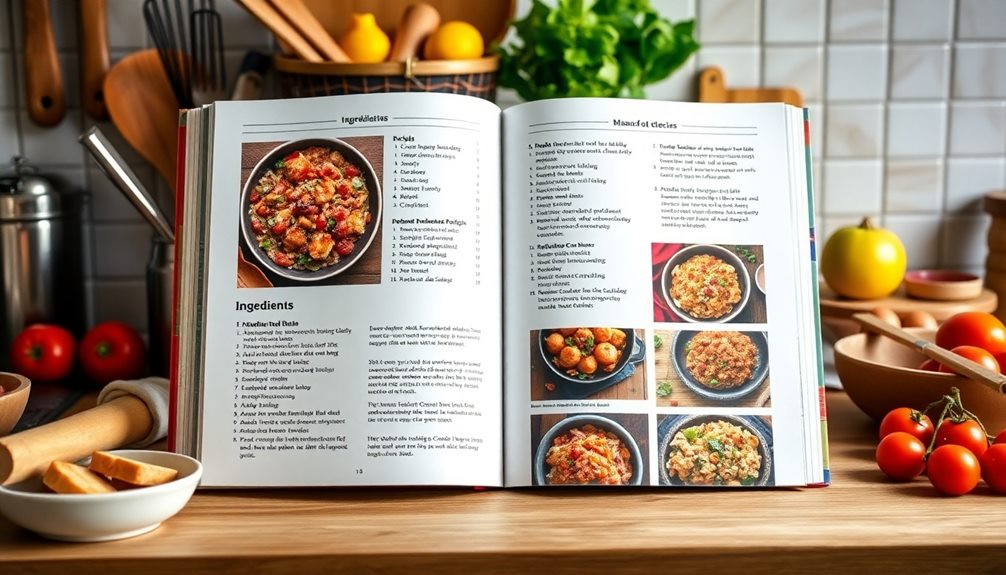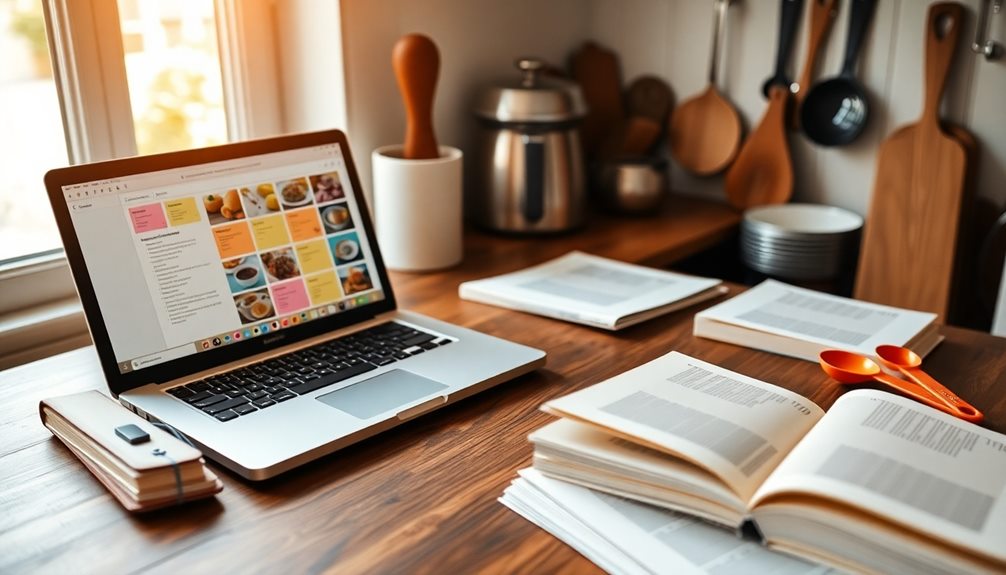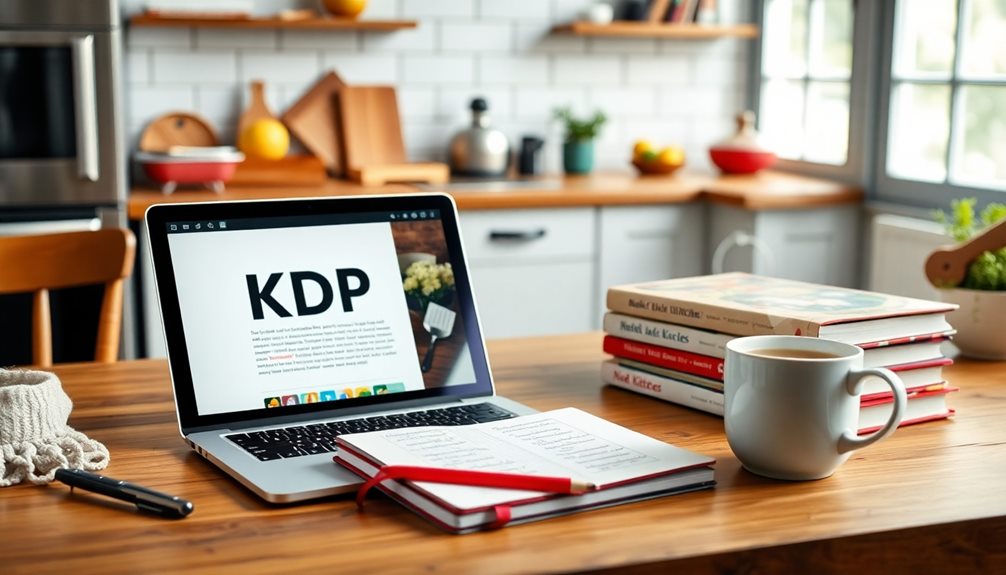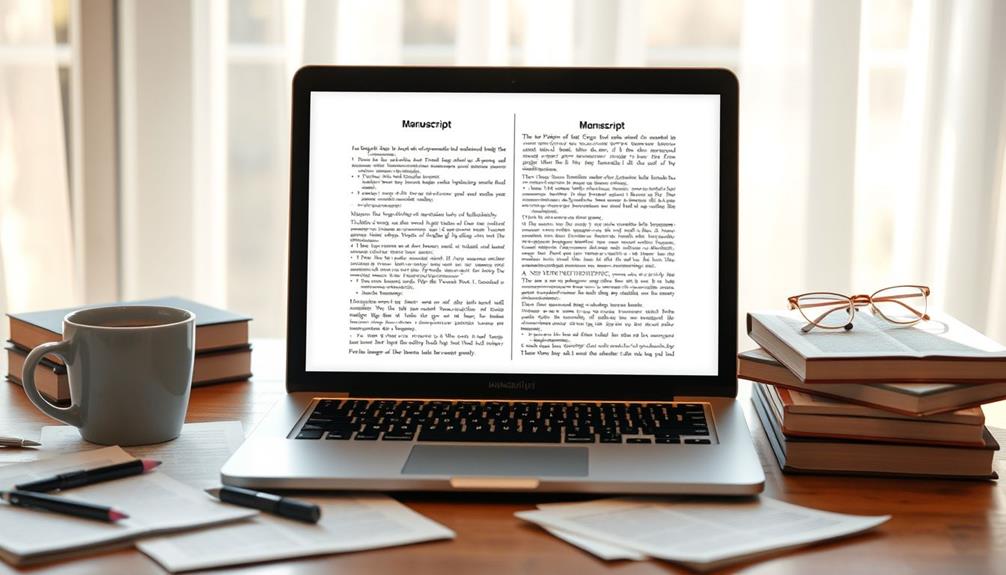Publishing cookbooks on KDP is an exciting venture that involves several key steps. First, identify a niche market, like vegan or keto, to target your audience. Create at least 20 clear and simple recipes, using tools like ChatGPT for inspiration. Structure each recipe with easy-to-follow instructions and high-quality images. When formatting, stick to a standard trim size for a professional look. Don't forget to craft an appealing cover—color and typography matter! Once your book's ready, set a competitive price, and promote it through social media. Keep going, and you'll discover even more valuable tips for success.
Key Takeaways
- Identify niche markets, such as vegan or gluten-free, to target specific audiences effectively and enhance marketing strategies.
- Structure recipes clearly with titles, serving sizes, and step-by-step instructions to improve reader engagement and usability.
- Utilize AI tools and design platforms like Canva for innovative recipe development and appealing cover creation.
- Set competitive pricing based on production costs and market research to ensure profitability and attract buyers.
- Implement marketing strategies, including social media promotion and collaborations with influencers, to increase visibility and sales.
Understanding Niche Markets

Understanding niche markets is essential for anyone looking to publish cookbooks on KDP. The demand for specialized diet cookbooks, like vegan, keto, and gluten-free options, has surged due to the rising consumer interest in health-conscious eating.
In fact, the number of vegan cookbooks has increased by 300% over the past five years, highlighting a lucrative opportunity for authors who cater to this specific audience. Incorporating popular ingredients, such as chia seeds in vegan recipes, can further attract health-conscious consumers and enhance the nutritional value of recipes.
By focusing on niche markets, you can create cookbooks that address specific dietary restrictions or preferences. This targeted approach allows for effective marketing that resonates with dedicated groups seeking innovative and practical recipes.
To enhance reader retention and boost sales, make sure to include a strong introductory section about the benefits of the specialized diet. Consumers are increasingly looking for informative content alongside recipes.
Additionally, leveraging AI tools for recipe development can streamline your process, helping you create unique dishes that fill gaps in the market. This strategy not only keeps your content fresh but also appeals to consumers enthusiastic for new culinary experiences.
Embracing niche markets will set you apart in the competitive cookbook landscape on KDP.
Recipe Creation Techniques

Creating recipes that resonate with your target audience starts with innovative thinking and a solid understanding of current dietary trends. To enhance your recipe creation process, consider using AI tools like ChatGPT to brainstorm unique ideas that cater to popular diets such as vegan, Keto, or plant-based. Aim to compile at least 20 simple yet nutritious recipes, ensuring each includes clear headings, serving sizes, ingredients, measurements, and step-by-step preparation instructions.
To inspire your creativity, here's a visual representation of recipe ideas based on dietary trends:
| Dietary Trend | Recipe Idea | Key Ingredient |
|---|---|---|
| Vegan | Chickpea Salad | Chickpeas |
| Keto | Cauliflower Rice Bowl | Cauliflower |
| Plant-Based | Quinoa Stuffed Peppers | Quinoa |
| Gluten-Free | Almond Flour Pancakes | Almond flour |
| Mediterranean | Greek Yogurt Parfait | Greek yogurt |
Incorporate visually appealing images generated via MidJourney to create engaging content. Additionally, regularly researching popular dietary trends will keep your recipes relevant and appealing, making your cookbook a must-have for readers.
Effective Recipe Structuring

When structuring your recipes, it's crucial to lay them out in a way that grabs attention and keeps readers engaged. Start with a clear recipe title that reflects the dish's essence. Next, include serving sizes to help readers plan accordingly. Incorporating elements such as self-regulation techniques can also enhance the cooking experience, as they encourage mindful cooking and increase focus on the task at hand.
Organize your ingredients in a bullet-point format, ensuring measurements are easy to read. Following that, provide step-by-step preparation instructions that are concise and straightforward. This enhances readability and user-friendliness, so your readers can follow along without confusion.
Consider incorporating nutritional information alongside each recipe. This can empower consumers to make informed dietary choices, aligning with their health goals. Maintain a consistent format across all recipe pages, using the same font style and size for a polished look.
Adding introductory paragraphs can engage your audience by offering context or personal anecdotes related to the dish. This not only makes the cookbook more relatable but also enriches the cooking experience.
Ultimately, these structuring elements work together to create a cookbook that's not only functional but also enjoyable to use.
Visual Presentation Strategies

Enhancing your cookbook's visual presentation can greatly elevate the reader's experience and engagement. Start by using high-quality images generated via tools like MidJourney. These images not only captivate but also guarantee consistent formatting across all recipe pages, which is vital for maintaining a professional look per book.
Additionally, consider incorporating colorful, nutritious ingredients that not only make the dishes visually appealing but also promote healthy eating habits safe snacks for hamsters.
Next, incorporate clear headings and an organized layout for each recipe. This improves readability and helps readers easily navigate through the content, making their cooking experience smoother and more enjoyable. Choosing a standard trim size of 7.5 x 9.25 inches is also fundamental; it guarantees your cookbook fits well on shelves and is easy to handle.
Don't overlook the importance of an eye-catching book cover. Use design platforms like Canva to create a glossy finish that attracts potential buyers and reflects the quality of the recipes inside.
Finally, include introductory pages that visually communicate the benefits of your dietary focus. This reinforces the theme and purpose of your cookbook, providing readers with a clear understanding of what to expect.
Book Formatting Essentials

Book formatting essentials play an essential role in guaranteeing your cookbook is user-friendly and visually appealing. The number one aspect to take into account is the standard trim size of 7.5 x 9.25 inches, along with a bleed adjustment of 0.125 inches for full-page images or designs. This guarantees your images and content fit perfectly, providing a polished look.
Next, focus on your recipe layout. Include clear headings, serving sizes, ingredients, measurements, and step-by-step preparation instructions for each recipe. This clarity will make it easier for readers to follow along.
Consistency is key—maintain a uniform format across all recipe pages. High-quality images, perhaps generated through platforms like MidJourney, can elevate your cookbook's overall presentation.
Additionally, think about using AI tools like ChatGPT to assist in generating innovative recipe ideas and structuring your content effectively. A glossy finish for your book cover enhances visual appeal and durability, making it more attractive to potential buyers.
Crafting an Appealing Cover

When crafting your cookbook cover, color psychology plays a key role in capturing attention and conveying your theme.
You'll also want to focus on typography and readability, ensuring that your title stands out and is easy to read at a glance.
Together, these elements can make your cover not just appealing, but also a powerful marketing tool.
Color Psychology Importance
A well-designed cover can make all the difference in attracting readers to your cookbook, and color psychology plays an essential role in that process. Different colors evoke specific emotions, so choosing the right palette is vital. For instance, if you're creating a vegan cookbook, green can suggest health and freshness, drawing in your target audience.
Studies show that vibrant and contrasting colors can greatly increase visibility, especially in the crowded cookbook genre. Warm colors like red and orange are especially effective, as they stimulate appetite and enthusiasm, making them ideal for food-related publications.
Consistency in color schemes across your cover and interior not only enhances branding but also aids in recognition, helping readers easily identify your book series or authorship.
Typography and Readability
An eye-catching cover doesn't just rely on color; typography plays a significant role in capturing attention and guaranteeing readability. You're going to keep potential readers engaged by choosing a legible font that aligns with your cookbook's theme.
Opt for a font size of at least 11-12 points for body text to guarantee clarity on both print and digital devices. Use contrasting colors for your text and background, like dark text on a light background, to enhance readability. This simple adjustment can make a world of difference.
Incorporate a hierarchy in your typography by varying font sizes and styles—bold for headings and italic for subheadings—to guide readers through your content seamlessly. Consistency is key, so maintain uniform spacing and alignment throughout your manuscript. A clean and organized layout improves the overall reading experience.
While decorative fonts can add flair, use them sparingly for titles or highlights, guaranteeing they complement the main text without sacrificing clarity. By focusing on these typography elements, you'll create a cover that's not only visually appealing but also easy to read, encouraging more readers to pick up your cookbook.
Navigating KDP Publishing Steps

Steering through the KDP publishing steps for your cookbook can be straightforward and rewarding. Start by creating an Amazon KDP account and initiating the paperback creation process. Don't forget to select the right trim size and interior color options.
Next, compile your recipes with clear headings, serving sizes, and detailed instructions. You can even leverage AI tools for recipe development. For your cover, utilize design platforms like Canva to create an eye-catching design that meets KDP's dimension requirements.
During setup, assign a free ISBN and categorize your book under relevant genres like Health, Fitness, or Vegan Diet to enhance visibility.
Here's a quick overview of the steps:
| Step | Action |
|---|---|
| Create KDP Account | Sign up on the Amazon KDP website |
| Compile Recipes | Organize with headings, sizes, and instructions |
| Design Book Cover | Use Canva to meet KDP's requirements |
Once everything's set, publish your cookbook, and keep an eye on the review status for final approval—usually within a few days. Embrace this journey, and you'll soon see your cookbook in the world!
Pricing Your Cookbook

When pricing your cookbook, start by analyzing your production costs, including printing expenses based on factors like page count and color interior.
Next, look at similar cookbooks in your niche to set a competitive price that reflects the quality of your content while ensuring a profit margin.
Cost Analysis Considerations
Pricing your cookbook effectively involves a careful analysis of multiple cost factors that can greatly impact your profit margins. Start by considering the printing costs; for a 7.5 x 9.25-inch book with a premium color interior, the average cost is around $4.20 per copy. If you set a suggested retail price of $12.00, you'll have an estimated royalty of $3.00 per book sold, which offers a reasonable profit margin.
However, don't stop there. You need to factor in additional expenses like marketing, cover design, and formatting when calculating your overall profitability. These cost analysis considerations are essential for making informed decisions.
Also, keep an eye on competitor pricing within your chosen categories, such as Health and Vegan Diet. This will help you position your cookbook competitively in the market.
Monitor your sales performance closely and be open to adjusting your pricing strategy based on consumer feedback and market trends. Remember, you're not locked into a price forever; flexibility can maximize your sales potential.
Competitive Pricing Strategies
Setting the right price for your cookbook is crucial for attracting buyers while ensuring you maintain a healthy profit margin. Start by determining your printing cost on KDP, as this directly influences your retail price. For instance, if your printing cost is $4.20, factor this into your pricing strategy.
Aim for a royalty of at least $3.00 per book sold, balancing affordability for consumers and profitability for you.
Next, research comparable cookbooks in your niche. Look at their length, content quality, and target audience to establish competitive pricing strategies. This will help you position your cookbook effectively in the market.
Don't forget about psychological pricing techniques—price your cookbook at $12.00 instead of $12.99 to make it more appealing to potential buyers.
Finally, regularly review and adjust your pricing strategy based on market trends, consumer feedback, and sales performance. This ongoing evaluation will help you maximize profitability and reach your target audience more effectively.
Marketing Your Cookbook

How can you effectively market your cookbook to stand out in a crowded market? First, leverage social media platforms like Instagram and Pinterest. These are fantastic for showcasing your visually appealing recipes and engaging with potential readers.
I'm going to recommend collaborating with food bloggers and influencers, too. Their established followings can help you reach wider audiences, making your cookbook more visible.
Next, consider implementing targeted ads on Amazon and social media. Focus on audiences interested in health, veganism, and specialized diets. Optimize these ads with keywords related to your cookbook's theme for better results.
Offering sample recipes or a free downloadable PDF on your website can also entice potential buyers. Use this opportunity to build an email list for future marketing efforts.
Lastly, encourage reader engagement through reviews and feedback on platforms like Goodreads and Amazon. Positive reviews can greatly influence purchasing decisions and enhance your cookbook's credibility.
Frequently Asked Questions
What Is the 10% Rule for KDP?
The 10% Rule for KDP lets you use up to 10% of your book's content for promotion. It's a great way to share excerpts and engage readers, boosting your visibility and potential sales.
Can I Self-Publish a Cookbook on Amazon?
Yes, you can absolutely self-publish a cookbook on Amazon! Just create a well-formatted manuscript, choose your niche, and upload it. Don't forget to market effectively to reach your target audience and boost sales.
How Much Does It Cost to Publish a Cookbook?
You might think publishing a cookbook is expensive, but it's not! It can cost you as little as $4.20 per book for printing, plus optional expenses for design and marketing. You can start with zero upfront fees.
Does KDP Ever Reject Books?
Yes, KDP can reject books for various reasons. You might face rejections due to formatting issues, insufficient content, copyright violations, or misleading titles. Always guarantee your manuscript meets their guidelines to avoid problems.
Conclusion
In wrapping up your journey to publishing a cookbook on KDP, remember that 70% of self-published authors report feeling more fulfilled than their traditionally published counterparts. By understanding niche markets, perfecting your recipes, and presenting your book beautifully, you're setting yourself up for success. Don't forget to price it thoughtfully and market it effectively. With passion and persistence, you can share your culinary creations with the world and inspire home cooks everywhere!









